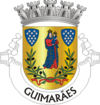Guimarães Municipality
| Guimarães | |||
|---|---|---|---|
| Municipality | |||

Clockwise from top left: Guimarães Castle, a chimney at the Duke of Braganza's Palace, statue of Dom Afonso Henriques at the Ducal Palace, Oliveira Plaza, panoramic view of Guimarães historical heritage area from Mount Penha, Santa Maria Street, Santiago Plaza
|
|||
|
|||
 |
|||
| Coordinates: 41°27′N 8°18′W / 41.450°N 8.300°WCoordinates: 41°27′N 8°18′W / 41.450°N 8.300°W | |||
| Country |
|
||
| Region | Norte | ||
| Subregion | Ave | ||
| Intermunic. comm. | Ave | ||
| District | Braga | ||
| Parishes | 48 | ||
| Government | |||
| • President | Domingos Bragança (PS) | ||
| Area | |||
| • Total | 241.3 km2 (93.2 sq mi) | ||
| Population (2011) | |||
| • Total | 158,124 | ||
| • Density | 660/km2 (1,700/sq mi) | ||
| Time zone | WET/WEST (UTC+0/+1) | ||
| Website | www |
||
 Aerial view of the Palace of the Dukes of Braganza (From IPPAR) |
|
| UNESCO World Heritage Site | |
|---|---|
| Location |
Portugal |
| Area | 242.85 km2 (2.6140×109 sq ft) |
| Criteria | ii, iii, iv |
| Reference | 1031 |
| Coordinates | 41°26′42″N 8°17′27″W / 41.445°N 8.2908°W |
| Inscription | 2001 (25th Session) |
| Website | www |
|
[]
|
|
Guimarães (Portuguese pronunciation: [ɡimɐˈɾɐ̃jʃ]) is a city and municipality located in northern Portugal, in the district of Braga. Its historic town center is listed as UNESCO World Heritage Site since 2001, in recognition for being an exceptionally well-preserved and authentic example of the evolution of a medieval settlement into a modern town in Europe.
Guimarães is also a part of the Ave Subregion (one of the most industrialised subregions in the country), as well as the historical Minho Province. The city has a population of 52,181 inhabitants. The population of the municipality in 2011 was 158,124, in an area of 240.95 square kilometres (93.03 sq mi). The current Mayor is Domingos Bragança, of the Socialist Party. The municipality is bordered to the north by the municipality of Póvoa de Lanhoso, to the east by Fafe, to the south by Felgueiras, Vizela and Santo Tirso, to the west by Vila Nova de Famalicão and the northwest by Braga.
The city was settled in the 9th century, at which time it was called Vimaranes. This denomination might have had its origin in the warrior Vímara Peres, who chose this area as the main government seat for the County of Portugal which he conquered for the Kingdom of Galicia.
Guimarães has a significant historical importance due to the role it played in the foundation of Portugal. The city is often referred to as the "birthplace of the Portuguese nationality" or "the cradle city" (Cidade Berço in Portuguese) because it is widely believed that Portugal's first King, Afonso Henriques, was born there, and also due to the fact that the Battle of São Mamede - which is considered the seminal event for the foundation of the Kingdom of Portugal - was fought in the vicinity of the city.
...
Wikipedia



